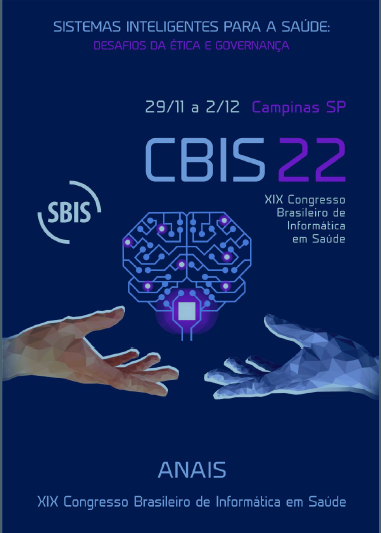Identifying Alzheimer's Disease Through Speech Using Emotion Recognition
DOI:
https://doi.org/10.59681/2175-4411.v15.iEspecial.2023.1093Palavras-chave:
Doença de Alzheimer, Análise Automática da Fala, Aprendizado de MáquinaResumo
A doença de Alzheimer é a demência neurodegenerativa mais comum em pessoas idosas no mundo e o seu diagnóstico requer uma ampla avaliação médica, apoiada por testes cognitivos, exames clínicos e de imagem. Identificar a doença através da fala pode reduzir o custo e o tempo do diagnóstico médico. Os estados emocionais são importantes indicadores de desempenho dos processos cognitivos. Técnicas computacionais inteligentes e não invasivas podem se tornar relevantes ferramentas de apoio para um diagnóstico médico precoce. Portanto, este trabalho aborda a utilização do reconhecimento de emoções através da voz como biomarcador para identificação da presença da doença de Alzheimer. O método proposto é baseado na extração das características emocionais da fala e no reconhecimento de padrões utilizando redes neurais. Os resultados dos experimentos alcançaram uma acurácia de 72,61%, uma precisão de 72,90% e uma revocação de 72,50% por intermédio da validação cruzada dos dados.
Referências
who.int [Internet]. Ageing - World Health Organization; c2022 [cited 2022 Aug 27]. Available from: https://www.who.int/health-topics/ageing.
Gauthier S, Webster C, Servaes S, Morais JA, Rosa-Neto P. World Alzheimer Report 2022: Life after diagnosis: Navigating treatment, care and support. London, England: Alzheimer’s Disease International (ADI); 2022.
Vizza P, Tradigo G, Mirarchi D, Bossio RB, Lombardo N, Arabia G, et al. Methodologies of speech analysis for neurodegenerative diseases evaluation. International Journal of Medical Informatics. 2019 Feb;122:45–54.
Alzheimer's Association. 2022 Alzheimer's Disease Facts and Figures. Chicago: Alzheimer's Association; 2022.
Liu L, Zhao S, Chen H, Wang A. A new machine learning method for identifying Alzheimer’s disease. Simulation Modelling Practice and Theory. 2020 Feb;99:102023.
Sharma P, Sharma A, Fayaz F, Wakode S, Pottoo FH. Biological signatures of Alzheimer Disease. Current Topics in Medicinal Chemistry. 2020 Apr 1;20.
Pulido MLB, Hernández JBA, Ballester MÁF, González CMT, Mekyska J, Smékal Z. Alzheimer’s disease and automatic speech analysis: A review. Expert Systems with Applications. 2020 Jul 15;150:113213.
Haider F, de la Fuente S, Albert P, Luz S. Affective Speech for Alzheimer’s Dementia Recognition. In Kokkinakis D, Lundholm Fors K, Themistocleous C, Antonsson M, Eckerström M, editors, LREC: Resources and Processing of linguistic, para-linguistic and extra-linguistic Data from people with various forms of cognitive/psychiatric/developmental impairments (RaPID). European Language Resources Association (ELRA). 2020. p. 67-73
de la Fuente Garcia S, Haider F, Luz S. Cross-corpus Feature Learning between Spontaneous Monologue and Dialogue for Automatic Classification of Alzheimer’s Dementia Speech. 2020 42nd Annual International Conference of the IEEE Engineering in Medicine & Biology Society (EMBC). 2020 Jul 20-24; Montreal, Canada. p. 5851-5855
Campbell EL, Mesía RY, Docío-Fernández L, García-Mateo C. Paralinguistic and linguistic fluency features for Alzheimer’s disease detection. Computer Speech & Language. 2021 Jul;68:101198.
Burkhardt F, Paeschke A, Rolfes M, Sendlmeier WF, Weiss B. A database of German emotional speech. In: Ninth European Conference on Speech Communication and Technology; 04-08 de setembro de 2005; Lisboa, Portugal. INTERSPEECH 2005. p. 1517-1520.
Becker JT, Boiler F, Lopez OL, Saxton J, McGonigle KL. The natural history of Alzheimer's disease: Description of study cohort and accuracy of diagnosis. Archives of Neurology. 1994 Jun; 51 (6): 585-594.
Husein Z. Malaya, Speech-Toolkit library. Version 1.2.7 [software]. 2020 [cited 2022 Aug 27]. Available from: https://github.com/huseinzol05/malaya-speech.
Wagner J, Triantafyllopoulos A, Wierstorf H, Schmitt M, Eyben F, Schuller BW. Dawn of the transformer era in speech emotion recognition: closing the valence gap. arXiv:2203.07378v2 [Preprint]. 2022 [cited 2022 Aug 27]: [25 p.]. Available from: https://arxiv.org/abs/2203.07378v2
Braga AC, Oliveira P. Diagnostic analysis based on ROC curves: theory and applications in medicine. International Journal of Health Care Quality Assurance. 2003 Jul 1. p. 191-198.
Downloads
Publicado
Como Citar
Edição
Seção
Licença
Copyright (c) 2023 Guilherme Bernieri, Julio Cesar Duarte

Este trabalho está licenciado sob uma licença Creative Commons Attribution-NonCommercial-ShareAlike 4.0 International License.
A submissão de um artigo ao Journal of Health Informatics é entendida como exclusiva e que não está sendo considerada para publicação em outra revista. A permissão dos autores para a publicação de seu artigo no J. Health Inform. implica na exclusiva autorização concedida aos editores para incluí-lo na revista. Ao submeter um artigo, ao autor será solicitada a permissão eletrônica de um Termo de Transferência de Direitos Autorais. Uma mensagem eletrônica será enviada ao autor correspondente confirmando o recibo do manuscrito e o aceite da Declaração de Direito Autoral.


